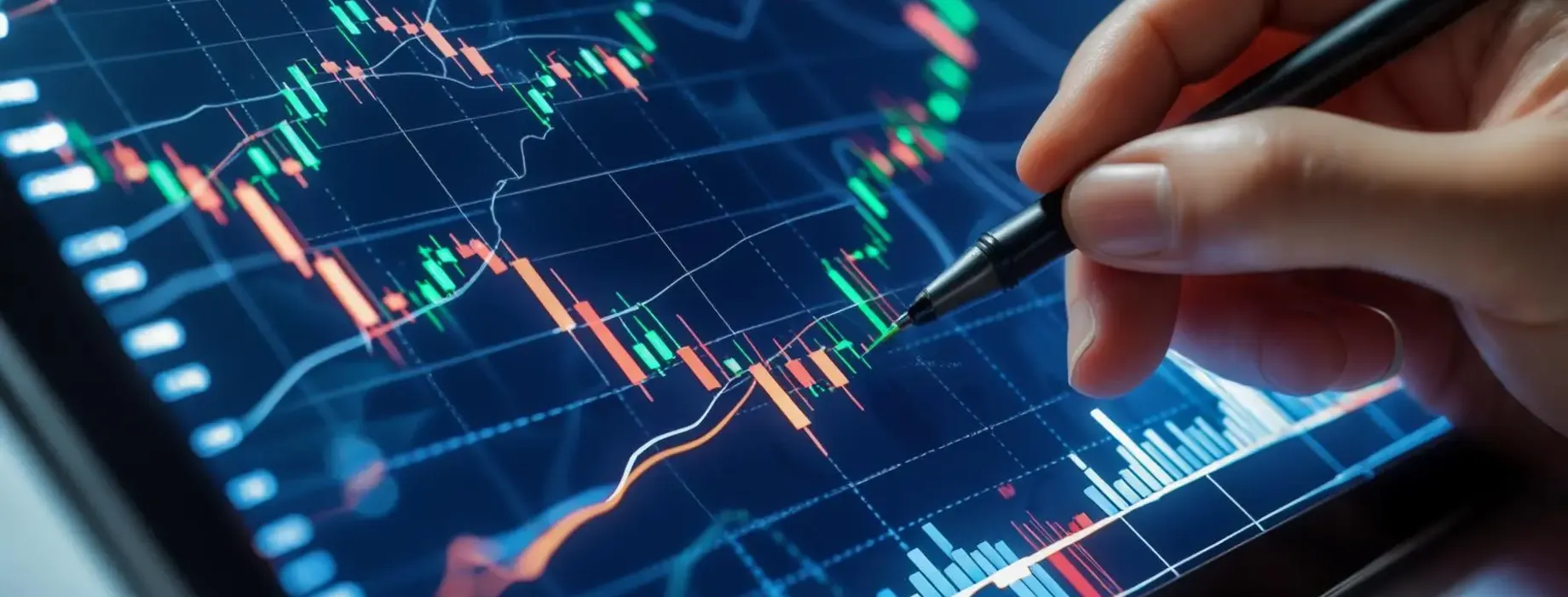- Strategic allocation: Long-term, stable ratios based on your risk
- Tacticalal location: Adjustments based on market trends or economic forecasts.
Building a Diversified Portfolio with ETFs in 2025

Investing with Confidence in 2025 Starts with Smart Diversification.
If there’s one thing that 2025 has taught us so far, it’s that markets rarely sit still. Interest rates, AI-driven sectors, global conflicts — the investment landscape keeps shifting, and anyone still relying on gut instinct or a couple of lucky stock picks is playing a dangerous game. That’s where ETFs come in.
Exchange-traded funds might not sound exciting at first, but they’re quietly one of the smartest tools available to everyday investors. Why? Because they let you spread your bets — across companies, industries, even countries — without having to become a financial analyst.
In this article, I’m not going to throw buzzwords or magic formulas at you. I’ll walk you through how I approach building a diversified ETF portfolio today — the same way I would explain it to a friend who’s serious about growing their wealth, not just chasing quick wins. Let’s cut through the noise and focus on what actually works.
What are ETFs and why are they more important than Sometime in 2025?
Exchange-Traded Funds, or ETFs, are basically baskets of different assets you can buy like a single stock. One ETF might hold dozens or even hundreds of companies, spreading your risk without needing to handpick each investment yourself. That’s the basic idea — but in 2025, it goes deeper.
Why now? Because the complexity of today’s market makes single-asset bets feel reckless. Tech stocks are soaring one week and crashing the next. Inflation data from Brazil, interest rate hikes in Europe, a policy shift in the U.S. — everything is connected. You need exposure to different sectors, regions, and asset types to stay resilient.
ETFs make that possible. Want access to clean energy? There’s an ETF for that. Want to balance between U.S. large caps and emerging markets? Covered. Bonds, commodities, real estate? All available in ETF form, and often with low fees.
Even better — many ETFs now use smart strategies under the hood. We’re not just talking about index tracking anymore. Some funds use AI-driven selection, others adjust allocations based on volatility or momentum. That means you can be diversified and tactical, which wasn’t so easy even five years ago.
In short: ETFs aren’t just safer. In 2025, they’re smarter, faster, and more flexible than ever — and they belong in any serious portfolio.
Why ETFs Are a Smart Tool for Diversifying Your Portfolio
In 2025, ETFs have cemented their place as one of the most efficient ways to achieve smart diversification. Their transparency is unmatched — most ETFs openly share their full list of holdings daily, so investors know exactly where their money is going. This level of clarity is rare in traditional fund structures.
Another big plus is their cost-efficiency. Compared to mutual funds, ETFs often come with much lower expense ratios and are widely available on platforms that charge zero commissions. For investors aiming to grow wealth long-term, minimizing hidden costs can significantly boost overall returns.
When it comes to diversification, ETFs shine. You can access global markets, niche industries, or specific sectors — all through a single instrument. Whether you’re looking for exposure to clean energy, emerging markets, or tech giants, there’s an ETF for that.
Finally, volatility control is a hidden strength of ETFs. Spreading assets across multiple regions and industries helps cushion the impact of sudden downturns in any one area, offering a more stable investment experience.
Types of ETFs Worth Considering in 2025
As ETF investing continues to grow in popularity, the variety of available ETFs has expanded dramatically. To build a truly diversified portfolio in 2025, it’s important to understand which ETF categories align with your financial goals and risk tolerance. Below is a breakdown of key ETF types and what they offer.
| ETF Type | Description | Why Considerin 2025 |
| Equity ETFs | Track a stock index (global, regional, or country-specific). | Gain broad market exposure or focus on specific economies. |
| Bond ETFs | Invest in short-term or long-term government and corporate bonds. | Balance risk and return, add income stability. |
| Thematic ETFs | Focus on long-term trends like AI, ESG, or green energy. | Align with global shifts and innovation-driven sectors. |
| Sector ETFs | Target industries such as tech, healthcare, or finance. | Capitalize on sector-specific growth opportunities. |
| REIT/Commodity ETFs | Provide exposure to real estate or raw materials like gold or oil. | Hedge against inflation and diversify outside traditional assets. |
In 2025, combining different types of ETFs can create a strong, balanced portfolio. For example, equity ETFs offer growth potential, bond ETFs provide income and safety, while thematic ETFs tap into future-forward industries. Don’t underestimate the role of commodities or real estate—they can provide uncorrelated returns, especially during market turbulence.
How to Build a Diversified Portfolio Using ETFs
Creating a well-balanced ETF portfolio begins with understanding your financial goals and investment horizon. Are you saving for retirement in 20 years or planning to buy a house in five? Your answers should determine how much risk you’re willing to take— and, therefore, how your portfolio is structured.
🎯 Sample Allocation Based on Moderate Risk Profile:
| Asset Type | Allocation | Purpose |
| Equity ETFs | 30% | Growth potential over the long term |
| Bond ETFs | 40% | Stability and regular income |
| Thematic ETFs | 20% | Exposure to innovative and future sectors |
| REIT/Commodity ETFs | 10% | Inflation hedge and alternative exposure |
This is just an example, but it highlights a balanced blend that fits many medium-risk investors in 2025.
🔄 Rebalancing Strategy
Over time, market performance shifts your portfolio’s weightings. Regular rebalancing—typically once or twice a year—helps maintain your target allocation and control risk. You can automate this with most brokers or manage it manually based on your preferences.
🧭 Strategic vs. Tactical Approach
Most investors benefit from a mix—keeping core holdings steady while making small tactical moves in response to opportunities or risks.
Mistakes to Avoid When Investing in ETFs
While ETFs offer an accessible way to diversify, investors often make avoidable errors that can undermine their portfolios.
Insufficient diversification within ETFs is a common pitfall. Some ETFs may seem diversified but concentrate too heavily on a few stocks or sectors, reducing true risk mitigation.
Ignoring fees and expenses can quietly erode returns. Even small management fees add up over time, so always check the ETF’s expense ratio before investing.
Blindly following market trends without understanding the underlying assets or risks leads to poor decision-making. Just because an ETF is popular doesn’t mean it suits your investment strategy.
Lastly, failing to monitor correlation between ETFs may result in overlapping holdings, reducing diversification benefits. Regularly reviewing your portfolio ensures each ETF adds unique value.
Avoiding these mistakes helps maintain a balanced, cost-effective portfolio tailored to your goals.
Conclusion
Building a diversified portfolio with ETFs is a smart strategy for 2025, combining accessibility, variety, and cost efficiency. By understanding your goals and selecting ETFs thoughtfully, you can create a balanced investment plan. Start small, stay consistent, and review regularly to make the most of your investments. ETFs offer a flexible, reliable way to navigate today’s markets and build long-term wealth.
Sources
Bloomberg – Comprehensive market data and ETF
Morningstar – ETF ratings, portfolio diversification strategies, and investment
Investopedia – Detailed guides on ETFs, portfolio building, and investment risk
WorldBank – Reports on global economic trends influencing investment decisions.
Financial Industry Regulatory Authority (FINRA) – Information on ETF risks and investor
FAQ
How much money do I need to start investing in ETFs?
You can start with as little as the price of one share, often under $100. Many platforms also offer fractional shares, making ETFs accessible to almost any budget.
Are ETFs safe during market downturns?
ETFs carry market risk like any investment, but diversified ETFs often reduce volatility compared to single stocks. Still, it’s important to understand the underlying assets.
Can I build a portfolio with only ETFs?
Absolutely. ETFs cover a wide range of asset classes, making them versatile enough for a complete portfolio.
How often should I review my ETF portfolio?
Review your portfolio at least once or twice a year, or after significant market changes, to rebalance and stay aligned with your goals.
